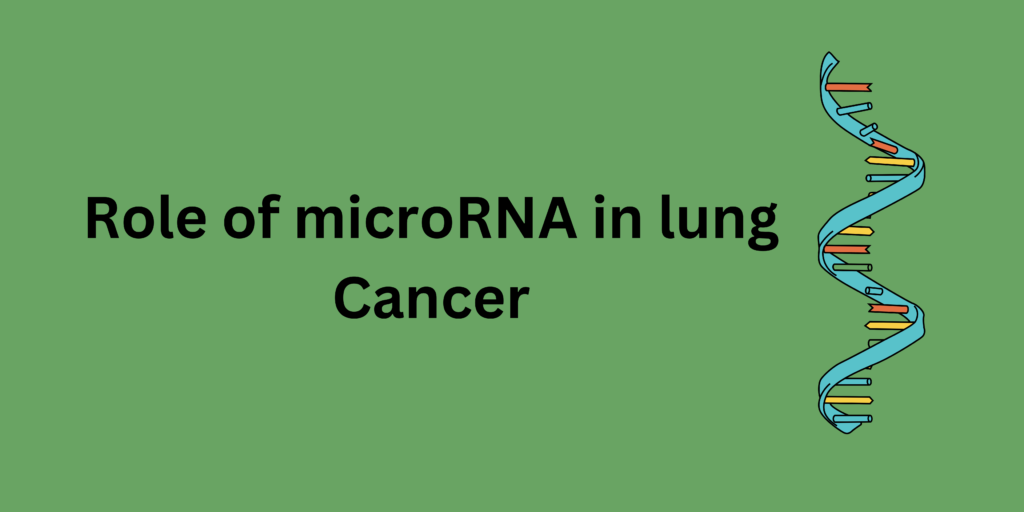Worldwide, lung cancer is the most deadly disease. Beyond genetics, the number and ability of epigenomic studies particularly those looking at microRNAs have increased intensely during the last ten years. This has extended our knowledge of the fundamental biology of cancer and opened up new paths for the development of possible treatments. Cancer has complicated behavior and development. Six hallmark potentials of cancer were fully illustrated by Hanahan et al. (2000). These comprised the ability to resist cell death, activate invasion and metastasis, activate proliferative signaling, enable replicative immortality, and elude growth suppressors. Ten years later, Hanahan and colleagues extra avoiding immune destruction and dysregulating cellular energetics to the original six hallmarks, design a total of eight. Additionally, Hanahan et al. believe that two tumor-enabling traits are heavy inflammation through genomic instability and mutation. It is believed that the two main features of cancer are unsuppressed cell growth and sustained cell proliferation. This course involves a numeral of genes and proteins, particularly kinases and kinase receptors (Van Roosbroeck & Calin, 2017) . The most well-known case of lung cancer signaling is by far the EGFR-signaling pathway. When ligands like transforming growth factor-α (TGF-α) or epidermal growth factor (EGF) attach to EGFR, the receptor is activated and becomes transphosphorylated. Two more important signaling pathways are provoked by this mechanism, including Ras/Raf/MEK/ERK and PI3K/Akt/mTOR, which further promote cell proliferation and cell cycle progression (Brambilla & Gazdar, 2009). The miRNAs miR-7, miR-27a-3p, miR-30, miR-34, miR-128, miR-133, miR-134, miR-145, miR-146, miR-149, miR-218, and miR-542-5p are those that straightly target EGFR.(Wu et al., 2019). Developing treatment targets in NSCLC contain echinoderm microtubule-associated protein-like 4 (EML4) and anaplastic lymphoma kinase (ALK) fusion proteins, which also twitch the Ras/Raf/MEK/ERK and PI3K/Akt/mTOR pathways (Karachaliou et al., 2014).
Unlike normal cells, which are lethal, cancer cells are immortal and have an unlimited capacity for replication. Telomerases, an enzyme that is related to telomeres, are the important components. A DNA polymerase called telomerase has the capacity to append repetitive sequences to the ends of telomeric DNA, which effects in the division of cells into successive generations. But practically all non-immortalized cells, which inevitably undergo cell senescence, lack telomerase (Hanahan & Weinberg, 2011). In various cancer cell types, a number of transcription factors, including Myc, HIF-1, and ER, stimulate the catalytic subunit of telomerase, hTERT (Kyo et al., 2008). Moreover, hTERT is the direct target of several miRNAs, which control telomere lengths. In head and neck squamous cell carcinoma, for instance, miR-512-5p targets hTERT and prevents tumor replication; in ovarian malignancies, miR-498 functions similarly. Currently, research on lung cancer cells has not reported any miRNAs that target hTERT. In addition to hTERT, DNA methyltransferases (DNMT) also control telomere length. The miR-29 family targets DNMT3A and DNMT3B in lung cancer cells, exhibiting a tumor-suppressive impact (Wu et al., 2019).
The prevention of programmed cell death, or so-called apoptosis, is one more characteristic of cancer. Extrinsic and intrinsic pathways are the two core routes that lead to cell apoptosis. The intrinsic pathway starts with different genotoxic agents, metabolic insults, or transcriptional cues sensed by BH3-only proteins and results in the inactivation of some BCL-2 family members. The extrinsic pathway is started by getting extracellular death-inducing signals via cell surface receptors, such as the Fas receptor. Eventually, both routes effect in the activation of caspases, which cause more cell death(Hanahan & Weinberg, 2011). According to Wang et al., miR-16-1 origins cell death in A549 cells by downregulating Bcl-2. According to Tian et al., the PPAR-γ/VEGF pathway permits miR-130b to indirectly upregulate Bcl-2, which in turn suppresses lung cancer cell death.
Upregulating the expression of the glucose transporter (GLUT1) and increasing glucose absorption may effect from the downregulation of miR-144 in lung cancer cells. Lactate dehydrogenase A (LDHA), an enzyme essential for glucose metabolism, is unpleasantly regulated by miR-33b, which also prevents NSCLC cell proliferation (Zhai et al., 2019). Many glycolytic enzymes are known to be improved in expression by HIF-1, and miR-199a has been shown to decrease the proliferation of lung cancer by decreasing HIF-1α and varying the glycolytic pathway(Ding et al., 2013).
Cancer cells avoid the immune system through the PD-L1/PD-1 pathway, where PD-L1 on tumor cells binds PD-1 on T-cells, hindering immune response. MicroRNAs like miR-34a, miR-197, and the miR-200 family control PD-L1 expression, impacting immune evasion. Low miR-200 expression leads to higher PD-L1 levels, reduced CD8+ T-cell infiltration, and increased tumor growth and metastasis in non-small cell lung cancer (NSCLC)(Wu et al., 2019).


